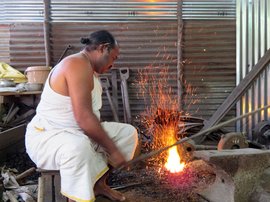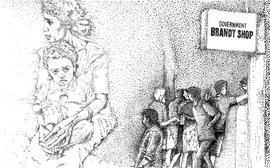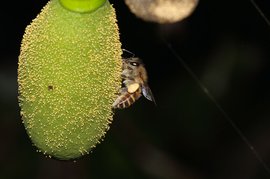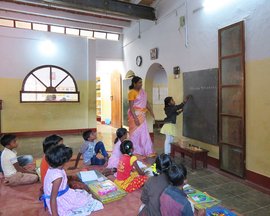Dear PARI Reader,
It’s been a busy year at www.ruralindiaonline.org .
As 2023 draws to a close, the PARI team has slated a series of year-end reviews headlined by striking visuals: every day, for the next nine days, we will be publishing our editors’ choices of the Best of PARI – stories, poems, music and illustrations, films, photos, translations, Library, FACES, social media and our engagement with students.
We continued to publish stories from across the country, and this year we added many from new locations, including the north east. Our coverage of agriculture now includes a meticulously researched series by Aparna Karthikeyan on jasmine, sesame, dry fish and more. A gripping series on farming can be read in Jaideep Hardikar’s relentless pursuit of the fall-out of man-animal conflict and its crushing impact on people who live near sanctuaries – ‘a new kind of drought’.
Palani Kumar shot unforgettable photographs of people at the margins – idol makers, trans actors, as well as fisherfolk in Tamil Nadu. Ritayan Mukherjee and Muzamil Bhat travelled with pastoralists across Kashmir and Ladakh to photograph them at work in the high mountains as they try to cope with a changing climate. Jyoti Shinoli covered many pressing injustices in rural Maharashtra – young athletes, education for children of migrants, menstruation taboos and more. And we had PARI Fellow Umesh K. Ray’s hard-hitting series from Bihar on the Musahar community and alcohol-related deaths.
We managed to cover new ground with stories around communities and conservation: Vishaka George found threats to the Bugun Liocichla, an endangered bird in the eastern Himalayas and how locals are helping mitigate the crisis; Priti David covered the critically endangered Great Indian Bustard in Rajasthan, and sacred groves taken over by renewable energy plants, so sacred no more.
We caught the news stories as they came – we walked with farmers protesting in Maharashtra, and spoke to Adivasis as they marched for their rights, as also striking anganwadi workers. And then, in the run-up to the December 2023 state elections in MP and Chhattisgarh, Parth M.N. was on the ground, writing about the lived realities of those hit by bulldozer injustice, atrocities on tribals and custodial deaths in these states going to the polls.
Reporting from the field often throws up short musafir pieces like the songs of women and the play of children in Murshidabad district where Smita Khator covered beedi workers. Some stories come with a personal touch as Medha Kale, also a teacher, wrote a celebratory piece on special-educators. Our reporters watched and covered festivals in rural India – Ma Bonbibi, Shaila Nritya, Chadar Badni, Pili Vesha, and we also have a piece, ‘Whose shrine is it anyway?’
We used the fact that the PARI team is spread
across multiple locations to bring in pan-India pieces on hapless gig workers, the
agony and the ecstasy of translations, migrant workers and migrant words, and even one on how women in rural
India spend their ‘leisure’ time. We hope to do more next year.


We covered festivals like (left) Pili Vesha, a folk art festival in coastal Karnataka, and also travelled with yak herders (right) in the Zanskar region of Ladakh
The Grindmill Songs Project (GSP) steered by Namita Waikar, of which PARI is immensely proud, is the gift that keeps on giving as it did this year too in a spectacular video on its history. In 2023, we added the Kutchi songs archive – recording songs from the Rann of Kutch, curated by in-house poet, Pratishtha Pandya.
Another first at PARI is the Adivasi Children’s Paintings – drawings by school children in rural Odisha, thoroughly vetted and painstakingly put together by Kanika Gupta. Artist Labani Jangi did our first story told through illustrations on women leading protests at the Deocha Pachami coal mines in West Bengal
PARI MMF Fellows recorded craftspeople in peril: in Maharashtra, Sanket Jain covered little known artisans in small villages who make jhopdis , jalis and more; from the playing fields of India; Shruti Sharma gave us a ringside view of not just craft, but the historical and socio-cultural setting surrounding critical sporting equipment; Prakash Bhuyan wrote from Majuli in Assam on the raas tradition there; Sangeeth Sankar on the tholpavakoothu traditions of north Kerala, and Faisal Ahmed on the bhoothas of Tulunadu, Karnataka.
Reporting from Andhra Pradesh, PARI Fellow Amrutha's stories on families in debt added to our growing coverage of stories with a focus on gender.
Besides the above, regular and old timers at PARI continued to contribute to our story archive: Purusottam Thakur wrote from Chhattisgarh and Jharkhand, sending in photos and videos on the lives, livelihoods and festivals of Adivasi communities; Shalini Singh continued following the Yamuna river’s displaced farmers and Urvashi Sarkar wrote on crab fishing and a quarterly magazine in the Sunderbans. Kavitha Iyer wrote on closure of rural schools in Odisha, S. Senthalir on women miners in Bellary, Sweta Daga on a Pride march in Himachal Pradesh, Jigyasa Mishra on brides for sale and Umesh Solanki on people who craft essentials like envelopes and sieves, and then Aakanksha on musicians in Mumbai locals, and Smitha Tumuluru on the Irulars of Tamil Nadu.
We had many articles from scholars and academics like Dr. Nitya Rao and Dr. Ovee Thorat on the universe of fishing in Cuddalore and herding in the Himalayas. Alongside their pieces were undergraduate and graduate scholars who wrote for PARI as a way to better understand the people and communities they are studying – denotified tribes, women dancers in rural Bihar, washer men and women in Kochi, and a high school student wrote on a postman in rural India.


We started a new collection of Adivasi children’s paintings (left) and also covered on-going protest by Adivasis from Aarey in Mumbai (right)
We begin with the Best of Mosaic – our selection of poetry, music and song this year that has expanded and deepened our archive. It will be followed by the Library team telling us which reports they want to highlight from hundreds they pored over to review for the PARI Library . The PARI Film team has delivered box office hits, and also debuted many film makers and videographers on our Youtube playlist. Among the most spectacular films came from within PARI – Shreya Katyayini on the burning of Madrasa Azizia, and Urja on saving the orans of Jaisalmer. Kavita Carneiro’s film on disenfranchised waste pickers was vintage PARI fare. You’ll hear more about these and other moving pictures in their year-end piece.
‘Every story published on PARI sees a reincarnation in 14 Indian languages.’ We see translated stories as impeccably done versions of a story that helps democratise the space. This is made possible by the efforts of PARIBhasha – the team of translators and language editors in Indian languages. Their year-end round-up will share the astonishing volume of work they have created.
Photos are central to PARI and see our selection of 2023's Photos and what PARI Internships mean for students. Don't miss our SM Highlight Reel showcasing our social media posts through the year. Finally we will end the year and begin the new one with the Editor's Choice of FACES on PARI – our flagship project that shows you India's facial diversity,
At the end of 2023, our tally of national and international awards for the nine years of PARI is an astounding 67, the most recent win in December from the UN Correspondents Association is by PARI co-founder, Shalini Singh. We believe the awards belong first to the everyday people who generously share their stories with us, as well as the reporters who walked with them, and the text, video, photo editors and translators who worked on it.
PARI editors work closely with reporters, advising them and fine-tuning the final content. They are critical to PARI and include our in-house text editors working in English and other Indian languages, our photo editor and the freelance editors who work with us.
Publishing an online journal and simultaneously building an archive is made possible by the PARI Desk who edit, fact check and do layouts. They start at the beginning working closely with reporters and stay till the end – bracing for a nit-picking final editorial check. No publishing task is beyond them and they embrace the challenge of getting content to dictate to form at the back-end!
We will be back with our regular publishing on January 2, 2024. Lined-up are the ‘well-of-death’ in Agartala’s fairs, Bihar’s chhapa artisans, communal policing in Maharashtra, Meerut’s iron workers and more.
In the coming year we aim to tell more stories – better reported, better shot and filmed, and better crafted – on the everyday lives of everyday people.
Thankyou!
PARI Team




